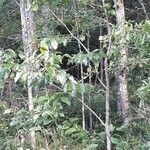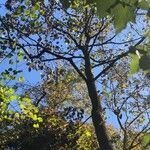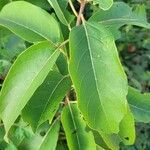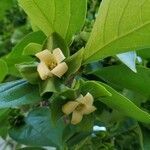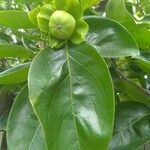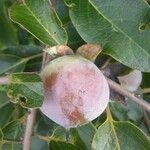Tree to 15 m, sometimes colonial, with deeply furrowed and cross-checked bark; lvs oval or oblong, 8–15 cm, shortly acuminate, on petioles 1–2 cm; fls greenish-yellow, the staminate solitary or 2–3 together, 1 cm., with usually 16 linear, acuminate anthers about as long as the cor-tube, the pistillate solitary, 1.5–2 cm, with larger cal and usually 8 sterile anthers; ovary mostly 8-locellar; fr yellowish-brown, 2–4 cm thick, edible after frost; 2n=60, 90. Mostly in dry woods; se. Conn. and s. N.Y. to Fla., w. to Io., Kans., and Tex. Var. virginiana, chiefly e. of the Miss. R., has glabrous twigs with thin lvs acute or cuneate at base and glabrous or nearly so beneath. Var. pubescens (Pursh) Dippel, chiefly w. of the Miss. R., has hirsutulous twigs with firm lvs broadly cuneate to rounded or subcordate at base and usually thinly but permanently hairy beneath.
A medium sized deciduous tree. It can be 30 m tall. In cultivation it is often only 6-9 m high. The bark is dark brown to black. It cracks into small squares. The leaves are alternate. The leaves are oval and 12 cm long by 7.5 cm across. They are pointed and do not have teeth. The flowers are separately male and female and on separate plants. They are bell shaped and about 1 cm long. The flowers are cream. The male flowers occur in clusters and the female ones occur singly. The fruit are small to medium sized and sweet. They are 3-4.5 cm across. They are green and ripen to reddish yellow or orange. They are sweet and edible.
